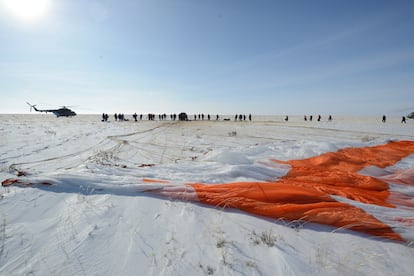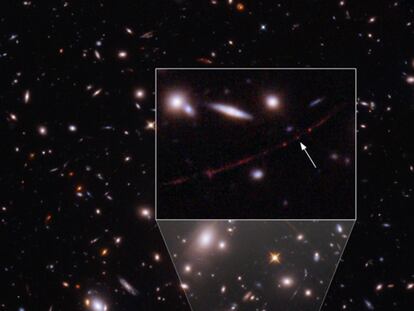The Ukraine war triggers Europe’s biggest space crisis
The European Space Agency is trying to determine how to stop depending on Russia, a move that could ultimately reinforce its own relevance in the sector

Fernando Rull is still trying to come to terms with the fact that the project to which he has dedicated the last 20 years of work is now up in the air due to the war in Ukraine. The physicist, who is from Granada in southern Spain, is leading the project for one of the instruments on the Rosalind Franklin rover, the biggest Mars exploration vehicle that has been developed in Europe and the first that is able to perforate the ground on the red planet to look for signs of underground life.
For a few weeks now, the rover has been sealed and ready to be sent into space, but its launch – planned on a Russian rocket in September – is going to be delayed for several years due to the sanctions being imposed against Russia. “It’s a tremendous blow, incredibly painful, but the war needs this response from Europe, it’s the priority,” says Rull.
The 22 countries in the European Space Agency (ESA) – Spain is one of them – have put this mission on hold after developing it in conjunction with Russia and contributing more than €1.3 billion ($1.42 billion) to the project.
Mars and Earth align every two years, meaning that the distance a spacecraft has to travel between the two planets is reduced to the minimum. Losing the opportunity to launch the rover in September will mean having to wait two years for another chance. Currently, there are three options under consideration. One is to leave everything as it is, hope that the crisis in Ukraine is swiftly concluded, and plan for the Rosalind Franklin to take off on a Russian Soyuz rocket in 2024, something that seems very unlikely.
“If we aim instead for 2026 and change the rocket, we would also have to develop a complete landing system, which was another one of Russia’s contributions as well as the Soyuz,” explains Rull. This is much more complex than it sounds. Only the United States and China have successfully landed a rover on Mars in the last 50 years.
“We would have to open the vehicle, which has already been disinfected, and include new components. Less than four years is a very short time to do all of that,” Rull warns. For the researcher, the most realistic option is to wait until 2028 and launch it on a European rocket, something that involves a major modification of the mission. “All instruments degrade with time and six years is too long,” he complains. “We would be launching something much older into space than we would now.”
Right now, thousands of engineers and scientists that work with the ESA are making an exhaustive evaluation of what Russia and Ukraine contribute to each one of the many programs currently underway. Each part, each line of computer code and each material used in the components of endless satellites, robotic probes, solar panels and rockets has to be checked.
There are some bizarre examples. It’s very laborious to check whether the titanium used in a component that has been assembled in a “friendly” country comes from Russia. Another major crisis is the fact that satellites need to be transported to their launch sites in enormous specialized aircraft. In many cases, the Antonov – built by Russia and Ukraine – was used. There are other alternatives, such as the Airbus Beluga, built in Europe. The problem is that there aren’t enough available planes for all the satellites waiting in line. They can be moved by sea, but this increases the journey by 14 days, meaning that the launch slot could be lost. It’s difficult to find a similar situation since the start of space exploration in Europe in the 1950s.
Despite how it might look now, this situation could be good for EuropeJorge Lomba, Spanish Center for the Development of Industrial Technology
“Just like the transportation, energy and food sectors, the space sector has suffered major breakdowns in the supply chain that are forcing the modification to the calendar for a lot of programs,” warns Jorge Lomba, the head of Space at Spain’s Center for the Development of Industrial Technology, which is the government organization that manages Spain’s participation in ESA missions. The economic cost of these delays will run to billions of euros, and if Europe wants to become independent from Russia in space, it will need an additional investment of various billions, this expert estimates.
Europe does not have an alternative for Soyuz rockets and spacecraft, something that will affect the ESA and many companies. Nor is there an alternative to the Soyuz capsules, which are used to take astronauts into space. The major hope is the Ariane 6, which was developed by the ESA. It is still in the testing phase and its first flight is planned for the end of this year. There are also Vega rockets, which are smaller, but the situation is equally critical in this case. There are only three that have been built so far and it is unknown whether more will come, given that they have an RD-843 engine that is built in Ukrainian cities currently being bombed. Indian and Chinese rockets also have Russian parts.
The only possible alternative in the short run is to buy Falcon rockets from Space X, the technology company founded and run by entrepreneur Elon Musk. It is possible, however, that many of the firm’s units have already been allocated. The company also makes Dragon capsules, which could replace the Soyuz.
The sanctions will also deal a severe blow to space exploration. The mission to the Moon planned by the ESA and Russia has been suspended, and an analysis is being made to work out what to do with the Russian scientists participating in the BepiColombo and Integral missions, which are currently operative.
Also in limbo is Euclid, a space telescope costing €600 million and that will analyze thousands of galaxies to try to answer questions about two of the main components of the universe: dark matter and dark energy.
“The situation is very uncertain,” explains Cristóbal Padilla, a researcher from the Institute for High Energy Physics in Spain, and a member of the Euclid mission. “Since the start of the war we have determined that the most feasible option is to launch an Ariane 6 instead of a Soyuz,” he explains. This would mean delaying the launch, which is planned for the start of 2023. “The Ariane 6 vibrates more than the Soyuz, meaning that a series of studies would have to be done to build a dampener so that the satellite is not damaged,” Padilla explains. This is a problem that other missions that were going to use the Soyuz will also face, such as a number of new satellites from the Galileo European GPS system.
This month, the ESA is expecting to have its first report on the impact of the sanctions on all of its missions, so that member countries can gather at an extraordinary meeting and decide which path to take and how much money they are prepared to pay to get out of this crisis. In the case of ExoMars, the report will arrive in October.
“Despite how it might look now, this situation could be good for Europe,” Lomba argues. “In the short term there will be extra costs, but now the aim is to do everything by ourselves, in a way that, in the medium term, could be beneficial because we will no longer depend on other countries; Europe would emerge stronger.”
If there is one program that, for now, is surviving the huge tensions caused by the war, it is the International Space Station (ISS). On the ISS, which orbits 400 kilometers (250 miles) above the Earth’s surface, Russian, American and European astronauts live side by side. Until now it has been operating as normal, including mixed crews making trips.
Since it was first put into orbit in 1998, the ISS has been an example of cooperation in space between countries that are sometimes at odds over economic and military issues. But it is far from clear as to how long this can last. The director of the Russian space agency, Dmitry Rogozin, has even voiced threats that the space station could end up crashing into the sea, and recently added that the project cannot go on should the West continue its economic sanctions against Russia.
The current agreement is to maintain the ISS operational for another two years, until 2024. Before the war, the US and Europe backed extending this date until 2030. Now it is likely that the conflict will also change the future of this advanced international space station.
Tu suscripción se está usando en otro dispositivo
¿Quieres añadir otro usuario a tu suscripción?
Si continúas leyendo en este dispositivo, no se podrá leer en el otro.
FlechaTu suscripción se está usando en otro dispositivo y solo puedes acceder a EL PAÍS desde un dispositivo a la vez.
Si quieres compartir tu cuenta, cambia tu suscripción a la modalidad Premium, así podrás añadir otro usuario. Cada uno accederá con su propia cuenta de email, lo que os permitirá personalizar vuestra experiencia en EL PAÍS.
¿Tienes una suscripción de empresa? Accede aquí para contratar más cuentas.
En el caso de no saber quién está usando tu cuenta, te recomendamos cambiar tu contraseña aquí.
Si decides continuar compartiendo tu cuenta, este mensaje se mostrará en tu dispositivo y en el de la otra persona que está usando tu cuenta de forma indefinida, afectando a tu experiencia de lectura. Puedes consultar aquí los términos y condiciones de la suscripción digital.
More information
Últimas noticias
Pinochet’s victims grapple with José Antonio Kast’s rise in Chile
Reinhard Genzel, Nobel laureate in physics: ‘One-minute videos will never give you the truth’
How Japan is trying to avert ‘digital defeat’
The complicated life of Francesca Albanese: A rising figure in Italy but barred from every bank by Trump’s sanctions
Most viewed
- Pablo Escobar’s hippos: A serious environmental problem, 40 years on
- Why we lost the habit of sleeping in two segments and how that changed our sense of time
- Charles Dubouloz, mountaineering star, retires at 36 with a farewell tour inspired by Walter Bonatti
- Trump’s obsession with putting his name on everything is unprecedented in the United States
- The Florida Keys tourist paradise is besieged by immigration agents: ‘We’ve never seen anything like this’











































